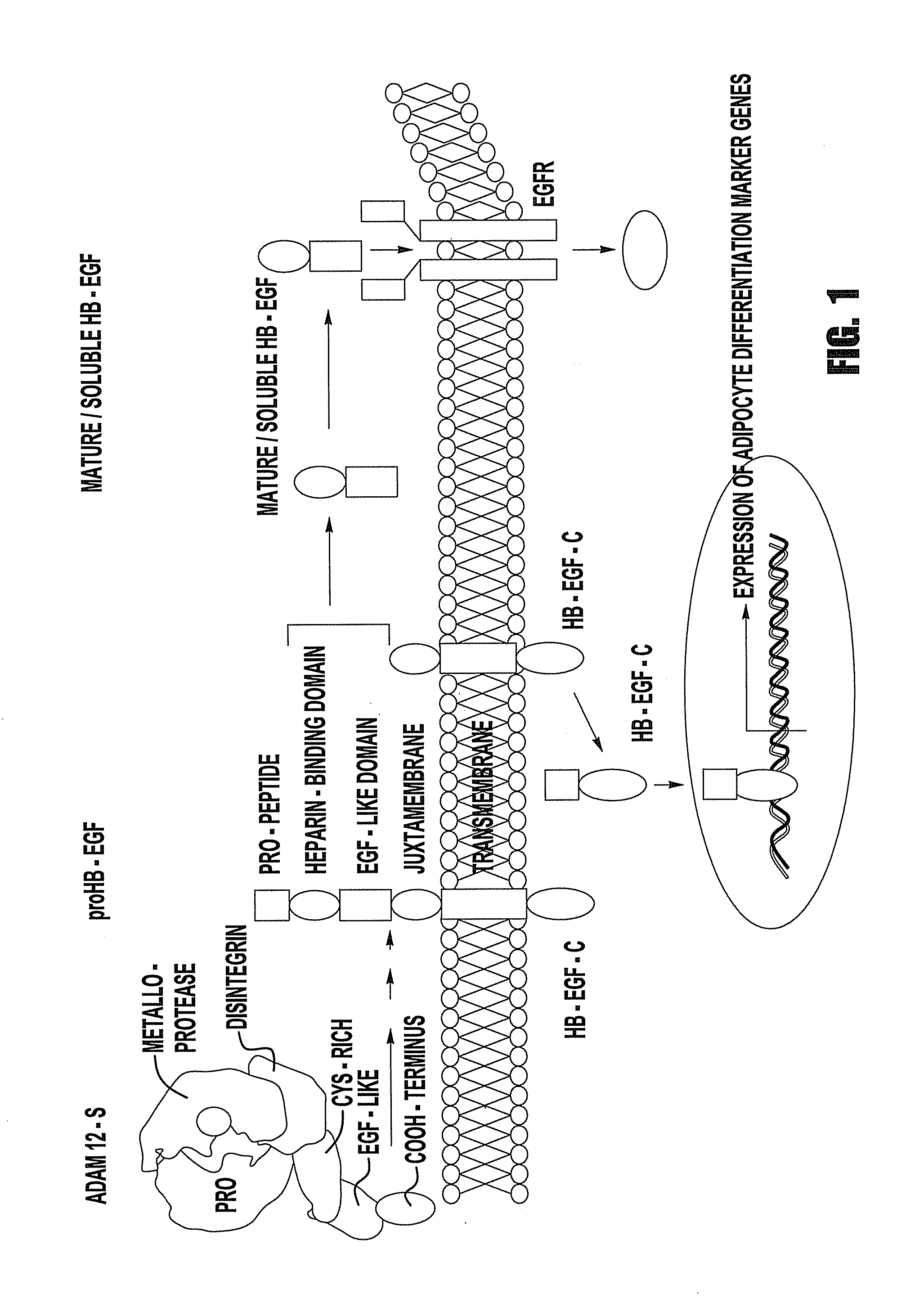Cell transdifferentiation into brown adipocytes
a technology of brown adipocytes and adipocytes, which is applied in the direction of drug compositions, genetic material ingredients, metabolic disorders, etc., can solve the problems of high service report morbidity and mortality
- Summary
- Abstract
- Description
- Claims
- Application Information
AI Technical Summary
Problems solved by technology
Method used
Image
Examples
example 1
Cloning of Human HB-EGF and Human ADAM 12S Expression Vector
[0076]Both human HB-EGF cDNA (627 bp) and human ADAM 12S cDNA (2,217 bp) were amplified by PCR from the plasmid pIRES:EGFP / hHB-EGF and pcDNA 3.0, respectively. PCR reactions contained 4 ng / μl of HB-EGF cDNA or ADAM 12S cDNA, 0.5 μl forward and reverse primers (10 μM), 2.0 μl of 10× reaction buffer, 0.5 μl dNTPs, 0.5 μl Taq polymerase (New England Biolabs, Beverly, Mass.), and dH2O to bring the volume to 20 μl. Each reaction was subjected to 94° C. (5 min), 35 cycles of 94° C. (30 s), 58° C. (1 min), and 72° C. (40 s), followed by an extension at 72° C. (10 min). Reaction products were separated by 0.8% agarose gel electrophoresis. The fragments of HB-EGF cDNA and ADAM 12S cDNA were then purified using gel extraction kit (QIAGEN), and cloned into pcDNA3.1 / V5-His-TOPO and pEF6 / V5-His TOPO expression vector, respectively (Invitrogen), shown in FIG. 5. The resulting plasmids were transformed into competent E. coli, isolated usi...
example 2
Construction of HB-EGFΔN and HB-EGFΔC Deletion Mutants
[0077]The full-length 627-bp human HB-EGF cDNA has previously been cloned into the MT-1 expression vector, pMT-1:HB-EGF (Harding et al. Growth Factors, 17, p. 49-61 (1999)). A 558 bp human HB-EGF cDNA encoding nucleotides 1-558 of exon 1 through exon 5 including a translational stop codon and a 246 bp human HB-EGF cDNA encoding nucleotides 382-627 of exon 3 through exon 5 including a translational start codon were amplified by PCR for HB-EGFΔN and HB-EGFΔC, respectively. PCR reactions were performed in a final volume of 20 μl containing 4 ng / μl of HB-EGF cDNA, 0.5 μl forward and reverse primers (10 μM), 2.0 μl of 10× reaction buffer, 0.5 μl dNTPs, and 0.5 μl Taq polymerase (New England Biolabs: Beverly, Mass.). Each reaction was subjected to 94° C. (5 min), 35 cycles of 94° C. (30 s), 57° C. (1 min), and 72° C. (40 s), followed by an extension at 72° C. (10 min). Reaction products were separated by 1.0% agarose gel electrophoresi...
example 3
Generation of Stable Mammalian Cell Lines Expressing proHB-EGF, ADAM 12, HB-EGFΔN or HB-EGFΔC
[0078]In order to determine whether the soluble, mature form of HB-EGF and / or HB-EGF C is responsible for stimulation of adipogenesis, cDNA constructs were cloned in which one lacks a functional, soluble, mature HB-EGF capable of binding to EGFRs, termed HB-EGFΔN yet maintaining the ectodomain processing site by ADAMs at Pro148-Val149. Nanba et al., Cytokine Growth Factor Rev., 15, 15-19 (2004). The second HB-EGF cDNA construct lacks a functional HB-EGF C domain, yet maintains the minimal amount of intracellular domain necessary for processing, termed HB-EGFΔC. Nanba et al., J. Cell Biol., 163, 489-502 (2003) ADAM 12S and either HB-EGFΔN or HB-EGFΔC were stably co-expressed in mouse fibroblasts.
[0079]Mouse fibroblasts or human epidermoid carcinoma (A431) cells were maintained in DMEM (Cellgro, Herndon, Va.) supplemented with 10% fetal bovine serum, penicillin (100 U / ml) and streptomycin (10...
PUM
| Property | Measurement | Unit |
|---|---|---|
| diameter | aaaaa | aaaaa |
| volume | aaaaa | aaaaa |
| volume | aaaaa | aaaaa |
Abstract
Description
Claims
Application Information
 Login to View More
Login to View More - R&D
- Intellectual Property
- Life Sciences
- Materials
- Tech Scout
- Unparalleled Data Quality
- Higher Quality Content
- 60% Fewer Hallucinations
Browse by: Latest US Patents, China's latest patents, Technical Efficacy Thesaurus, Application Domain, Technology Topic, Popular Technical Reports.
© 2025 PatSnap. All rights reserved.Legal|Privacy policy|Modern Slavery Act Transparency Statement|Sitemap|About US| Contact US: help@patsnap.com



